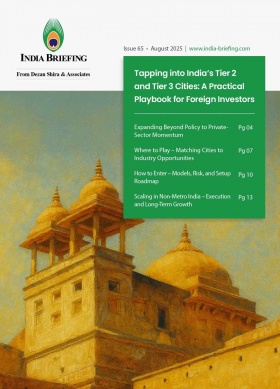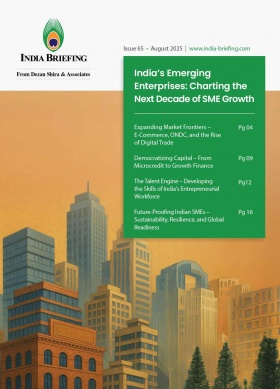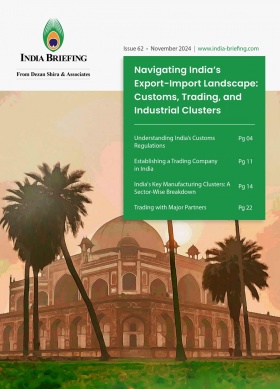India Manufacturing Tracker 2025
India is keen to expand its manufacturing sector, with a focus on diversifying into newer lines of production, advancing the industrial capacity of traditional sectors like automobiles, and establishing a globally competitive domestic supply chain ecosystem.
India’s government is actively pushing to raise the share of manufacturing in the national economy through flagship programs such as the Production-Linked Incentive (PLI) scheme, covering 14 key sectors, and a wide range of state-level industrial policies.
Over the past decade, India’s manufacturing sector has expanded steadily but has yet to fully capitalize on the country’s vast labor pool and domestic market. India’s manufacturing momentum has picked up, fueled by rising foreign investment and the relocation strategies of global manufacturers seeking to diversify supply chains beyond China.
In FY 2024-25, the manufacturing output was 4.26 percent, a substantial growth from 1.4 percent in FY 2023-24.
Against this backdrop, India Briefing presents the 2025 India Manufacturing Tracker – highlighting key production trends, industry statistics, and government initiatives shaping the sector’s trajectory.
India’s Purchasing Managers’ Index (PMI)
|
India’s PMI month-on-month |
Output (%) |
|
November 2025 |
56.6 |
|
October 2025 |
59.2 |
|
September 2025 |
57.7 |
|
August 2025 |
59.3 |
|
July 2025 |
59.1 |
|
June 2025 |
58.4 |
|
May 2025 |
57.6 |
|
April 2025 |
58.2 |
|
March 2025 |
58.1 |
|
February 2025 |
58.8 |
|
January 2025 |
57.7 |
Source: HSBC India Manufacturing PMI
The Purchasing Managers’ Index (PMI) is an economic indicator based on monthly surveys of companies. It tracks trends in both the manufacturing and services sectors, showing whether business conditions are expanding, contracting, or staying the same. PMI is important for predicting the economic health of a country and is closely monitored.
There are two types of PMI:
- Manufacturing PMI
- Services PMI
A combined PMI includes both sectors.
How is manufacturing PMI calculated?
The PMI is derived by sending fact-based questions to a large number of companies in the concerned sector. For manufacturing PMI, the questionnaire is sent to manufacturing companies. The questions are factual in nature, and the survey is not meant for opinions, intentions, or expectations.
The PMI is based on five key factors:
- New orders (30%)
- Output (25%)
- Employment (20%)
- Suppliers’ delivery times (15%)
- Stock of items purchased (10%)
A PMI above 50 indicates business expansion, while below 50 signals contraction. The difference between 50 and the previous month’s data shows the rate of change.
PMI is released before other economic indicators like GDP and industrial output, offering early insight into economic trends. It’s useful for manufacturers, suppliers, and investors to gauge economic health and make informed decisions.
India’s Index of Industrial Production (IIP)
In India, the Index of Industrial Production (IIP) tracks the growth rates of three key sectors—mining, manufacturing, and electricity—on a month-on-month basis. Manufacturing remains the largest contributor, accounting for 77.63 percent of total industrial production.
According to the IIP data released by the Ministry of Statistics & Programme Implementation on August 28, 2025, within the manufacturing sector, 14 out of 23 industry groups at NIC 2 digit-level have recorded a positive growth in July 2025 over July 2024. The top three positive contributors for the month of July 2025 were:
- Manufacture of basic metals: 12.7 percent
- Manufacture of electrical equipment: 15.9 percent
- Manufacture of other non-metallic mineral products: 9.5 percent
|
Month |
IIP growth over the corresponding period of previous year |
|
October 2025 |
0.4% |
|
September 2025 |
4.0% |
|
August 2025 |
4.0% |
|
July 2025 |
3.5% |
|
June 2025 |
1.5% |
|
May 2025 |
1.9% |
|
April 2025 |
2.6% |
|
March 2025 |
3.0% |
|
February 2025 |
2.9% |
|
January 2025 |
5.0% |
Source: PIB
Reading the IIP data
The Ministry of Statistics and Programme Implementation (MoSPI) will release the quick estimates of the IIP on the 28th of every month, or on the next working day if the 28th is a holiday.
October 2025:
- The IIP growth rate for the month of October 2025 stood at 0.4 percent, a sharp decline from 4 percent in the previous month. As per the Ministry of Statistics and Programe Implementation (MoSPI), the slow growth in the month could be attributed to less number of working days on account of several major Indian festivals in the month.
- The growth rates of the three sectors, mining, manufacturing and electricity for the month of October 2025 are (-) 1.8 percent, 1.8 percent and (-) 6.9 percent respectively.
- Within the manufacturing sector, the top three positive contributors for the month of October 2025 are – “manufacture of basic metals” (6.6 percent), “manufacture of coke and refined petroleum products” (6.2 percent) and “manufacture of motor vehicles, trailers and semi-trailers” (5.8 percent).
September 2025:
- The IIP growth rate for September stood at 4 percent; unchanged from the previous month.
- The growth rates of the three sectors, mining, manufacturing and electricity for September 2025 are (-)0.4 percent, 4.8 percent and 3.1 percent respectively.
- Within the manufacturing sector, 13 out of 23 industry groups at NIC 2 digit-level have recorded a positive growth in September 2025 over September 2024. The top three positive contributors for the month of September 2025 are – “manufacture of basic metals” (12.3 percent), “manufacture of electrical equipment” (28.7 percent) and “manufacture of motor vehicles, trailers and semi-trailers” (14.6 percent).
August 2025:
- The IIP growth rate for the month of August 2025 is 4.0 percent.
- The growth rates of the three sectors, mining, manufacturing and electricity for the month of August 2025 are 6.0 percent, 3.8 percent and 4.1 percent respectively.
- Within the manufacturing sector, 10 out of 23 industry groups at NIC 2 digit-level have recorded a positive growth in August 2025 over August 2024. The top three positive contributors for the month of August 2025 are – “manufacture of basic metals” (12.2 percent), “manufacture of coke and refined petroleum products” (5.4 percent) and “manufacture of motor vehicles, trailers and semi-trailers” (9.8 percent).
July 2025:
- India’s Index of Industrial Production (IIP) grew by 3.5 percent in July 2025. Sector-wise, mining contracted by 7.2 percent, while manufacturing expanded by 5.4 percent and electricity rose by 0.6 percent.
- Within manufacturing, 14 out of 23 industry groups recorded growth compared to July 2024.
- The key contributors were basic metals, which grew by 12.7 percent, electrical equipment, which registered 15.9 percent growth, and other non-metallic mineral products, which increased by 9.5 percent.
June 2025:
- India’s IIP growth slowed to a 10-month low of 1.5 percent in June 2025, primarily due to a sharp contraction in mining and a decline in power output, both affected by the early arrival of monsoon rains. In contrast, manufacturing output saw a modest rise of 3.9 percent, slightly up from 3.5 percent in June 2024.
- The National Statistics Office (NSO), in a report released on July 28, 2025, revised May 2025’s industrial growth to 1.9 percent from an earlier estimate of 1.2 percent.
- As per data released by the MoSPI on July 21, 2025, India’s Index of Eight Core Industries (ICI) registered a year-on-year growth of 1.7 percent in June 2025. Sectors such as steel, cement, and petroleum refinery products contributed positively during the month.
May 2025:
- As per the provisional IIP figures released on June 30, 2025, India’s industrial production growth rate for the month of May is 1.2 percent. The growth rates of the three sectors, mining, manufacturing, and electricity are -0.1 percent, 2.6 percent, and -5.8 percent, respectively.
- Within the manufacturing sector, the top three positive contributors for the month of May 2025 are manufacture of basic metals (6.4 percent), manufacture of machinery and equipment (11.8 percent), and manufacture of other non-metallic mineral products (6.9 percent).
April 2025:
-
As per the latest IIP figures released on May 28, 2025, India’s industrial production growth rate for the month of April 2025 is 2.6 percent, a dip from the IIP rate of 3 percent in March. The growth rates of the three sectors, mining, manufacturing, and electricity, for the month of April 2025 are (-)0.2 percent, 3.4 percent, and 1.1 percent, respectively.
March 2025:
- On April 28, 2025, India’s IIP growth rate for March 2025 was reported at 3.0 percent, compared to 2.9 percent (quick estimate) recorded in February 2025.
- Per the latest IIP figures, the growth rates of the three sectors, mining, manufacturing and electricity for the month of March 2025 are 0.4 percent, 3.0 percent and 6.3 percent respectively.
- Within the manufacturing sector, the top three positive contributors for the month of March 2025 are – “manufacture of basic metals” (6.9 percent), “manufacture of motor vehicles, trailers and semi-trailers” (10.3 percent) and “manufacture of electrical equipment” (15.7 percent).
February 2025:
- As per the latest IIP figures, the growth rates of the three sectors, mining, manufacturing and electricity for the month of February 2025 are 1.6 percent, 2.9 percent and 3.6 percent respectively.
- Within the manufacturing sector, 14 out of 23 industry groups at NIC 2 digit-level recorded a positive growth in February 2025 over February 2024.
- Within the manufacturing sector, the top three positive contributors for the month of February 2025 are – “manufacture of basic metals” (5.8 percent), “manufacture of motor vehicles, trailers and semi-trailers” (8.9 percent) and “manufacture of other non-metallic mineral products” (8 percent).
January 2025:
- As per the latest IIP figures, the growth rates of the three sectors i.e., mining, manufacturing and electricity were 4.4 percent, 5.5 percent and 2.4 percent respectively.
- Within the manufacturing sector, the top three positive contributors for the month were production of basic metals (6.3 percent), coke and refined petroleum products (8.5 percent) and electrical equipment (21.7 percent).
India’s GDP growth rate
In India, the GDP growth rate measures the change in the value of goods and services produced each quarter, adjusted for seasonal variations. India is the fifth-largest economy globally and the second most populous country.
As of September 2025, the country’s real GDP growth is estimated at 6.5 percent in FY 2025-26. The real GDP growth for FY 2026-27 is anticipated to grow percent to 6.4 percent.
Sector-wise GDP in India in 2024-25
Services: 54.93 percent
- Public administration, defense, and other services: 14.55 percent
- Financial, real estate, and professional services: 22.92 percent
- Trade, hotel, transport, communications, and services related to broadcasting: 17.51 percent
Industry: 27.13 percent
- Mining and quarrying: 2 percent
- Manufacturing: 14 percent
- Electricity, gas, water supply, and other utilities services: 3 percent
- Construction: 9 percent
Agriculture (including forestry and fisheries): 17.94 percent
|
Quarterly assessment |
GDP growth rate |
|
Q1 2025-26 |
7.8 |
|
Q4 2024-25 |
7.4 |
|
Q3 2024-25 |
6.4 |
|
Q2 2024-25 |
5.6 |
|
Q1 2024-25 |
6.5 |
|
Quarterly assessment |
Manufacturing sector contribution to India’s GDP |
|
|
|
Value in INR trillion |
Value in US$ billion |
|
Q1 2025-26 |
7.61 |
86.38 |
|
Q4 2024-25 |
8.29 |
94.1 |
|
Q3 2024-25 |
6.95 |
78.89 |
|
Q2 2024-25 |
7.20 |
81.73 |
|
Q1 2024-25 |
7.06 |
80.14 |
|
Employment Across the Manufacturing Sector in India from FY 2020 to FY 2023 |
|
|
Year |
Employment (in millions) |
|
2020 |
16.6 |
|
2021 |
16.08 |
|
2022 |
17.2 |
|
2023 |
18.49 |
Source: PLFS Data
According to the Annual Survey of Industries (ASI), employment in India’s manufacturing sector dipped slightly in 2020-21 due to the pandemic but rebounded with 7 percent year-on-year growth in 2021-22, surpassing pre-pandemic levels by over 935,000 workers. Average salaries also rose, with a 1.7 percent increase in 2020-21 and an 8.3 percent rise in 2021-22.
India’s manufacturing sector showed resilience, with Gross Value Added (GVA) increasing by 26.6 percent in 2021-22, driven by strong growth in key industries like basic metals, pharmaceuticals, and motor vehicles. The top five states employing the highest number of persons in this sector were Tamil Nadu, Gujarat, Maharashtra, Uttar Pradesh and Haryana in ASI 2020-21 as well as in ASI 2021-22.
The ASI noted that despite various challenges, the manufacturing sector showed a strong recovery, with significant gains in invested capital, output, and profits.
Production-linked incentives in India
The PLI scheme was first launched in 2020 and, as of 2025, includes 14 sectors within it. As per the central government, as of August 2024, the cumulative investments in the target sectors have reached INR 1.46 trillion (US$16.06 billion). It is estimated that investments will surpass INR 2 trillion (US$23 billion) in the coming year.
|
S. no. |
Sectors |
Budget outlay (in billions) |
Tenure |
|
1 |
Mobile Manufacturing and Specified Electronic Components |
INR 409.95 (US$4.8 billion) |
5 years |
|
2 |
Critical Key Starting Materials/Drug Intermediaries & Active Pharmaceutical Ingredients |
INR 69.50 (US$827 million) |
10 years |
|
3 |
Manufacturing of Medical Devices |
INR 34.20 (US$407 million) |
8 years |
|
4 |
Automobiles and Auto Components |
INR 570.42 (US$6.7 billion) |
5 years |
|
5 |
Pharmaceuticals Drugs |
INR 150 (US$1.78 billion) |
5 years |
|
6 |
Specialty Steel |
INR 63.22 (US$753 million) |
5 years |
|
7 |
Telecom & Networking Products |
INR 121.95 (US$1.4 billion) |
5 years |
|
8 |
Electronic/Technology Products |
INR 50 (US$595 million) |
4 years |
|
9 |
White Goods (ACs and LEDs) |
INR 62.38 (US$743 million) |
5 years |
|
10 |
Food Products |
INR 109 (US$1.2 billion) |
6 years |
|
11 |
Textile Products: MMF segment and technical textiles |
INR 106.83 (US$1.2 billion) |
5 years |
|
12 |
High efficiency solar PV modules |
INR 45 (US$536 million) |
5 years |
|
13 |
Advanced Chemistry Cell (ACC) Battery |
INR 181 (US$2.1billion) |
5 years |
|
14 |
Drones and Drone Components |
INR 1.2 (US$14.2 million) |
3 years |
Central government policies on manufacturing
|
Union Ministry |
National Policies on Manufacturing |
|
Ministry of Textile |
|
|
Ministry of heavy industries and public enterprise |
|
|
Ministry of Steel |
|
|
Ministry of Food Processing Industries |
|
|
Ministry of Housing and Urban Affairs |
|
|
Ministry of Electronics and Information Technology |
|
|
Ministry of Commerce and Industry |
|
|
Ministry of Petroleum and Natural Gas |
|
Manufacturing schemes in India
|
Union Ministry |
Manufacturing Schemes |
|
Ministry of Textile |
|
|
Ministry of Heavy Industries and Public Enterprise |
|
|
Ministry of Steel |
|
|
Ministry of Food Processing Industries |
|
|
National Horticulture Board |
|
|
Ministry of Electronics and Information Technology |
|
|
Ministry of Commerce and Industry |
|
|
Department of Animal Husbandry, Diary and Fisheries |
|
|
Bureau of Energy Efficiency |
|
|
Ministry of Agriculture and Farmers Affairs |
|
Source: NITI Aayog
State-level policies for manufacturing
|
State |
Manufacturing-Specific Policies |
|
Andhra Pradesh |
|
|
Arunachal Pradesh |
|
|
Assam |
|
|
Bihar |
|
|
Chhattisgarh |
|
|
Goa |
|
|
Gujarat |
|
|
Haryana |
|
|
Himachal Pradesh |
|
|
Jharkhand |
|
|
Karnataka |
|
|
Kerala |
|
|
Madhya Pradesh |
|
|
Maharashtra |
|
|
Manipur |
|
|
Meghalaya |
|
|
Mizoram |
|
|
Nagaland |
|
|
Odisha |
|
|
Punjab |
|
|
Rajasthan |
|
|
Sikkim |
Nil |
|
Tamil Nadu |
|
|
Telangana |
|
|
Tripura |
Nil |
|
Uttarakhand |
|
|
Uttar Pradesh |
|
|
West Bengal |
|
|
Andaman and Nicobar Islands |
|
|
Chandigarh |
|
|
Dadra and Nagar Haveli and |
|
|
The Government of NCT of Delhi |
|
|
Jammu & Kashmir |
|
|
Ladakh |
|
|
Lakshadweep |
Nil |
|
Puducherry |
|
Source: NITI Aayog
Foreign direct investment in India’s manufacturing sector
India’s FDI policy, which allows up to 100 percent foreign investment in most sectors under the automatic route, has made the country an attractive global investment hub. As a result, the overall FDI inflows have risen steadily – from US$36.05 billion in FY 2013-14 to a provisional US$81.04 billion in FY 2024-25, marking a 14 percent increase over the previous year.
Expansion of manufacturing FDI
A key driver of this growth is the sharp increase in investments flowing into the manufacturing sector. In FY 2024–25, manufacturing FDI rose 18 percent year-on-year, reaching US$19.04 billion compared to US$16.12 billion in FY 2023–24. Between April 2014 and March 2025, the manufacturing sector alone attracted US$184.15 billion in FDI equity inflows. This expansion underscores global confidence in India’s industrial ecosystem, bolstered by structural reforms, infrastructure improvements, and policy support for domestic value addition.
Sectoral opportunities
While services remain the top FDI recipient, manufacturing is steadily expanding its share. Investments are concentrated in high-growth industries such as electronics, automotive, chemicals, and consumer goods. Policy reforms – such as permitting 100 percent FDI in contract manufacturing and coal mining, along with the proposed increase in insurance sector FDI limits to 100 percent for companies reinvesting premiums domestically – have further strengthened India’s appeal as a global manufacturing hub.
This surge in FDI signals India’s shift from being largely a services-driven FDI destination to a balanced hub for both services and high-value manufacturing investments.
The “Make in India” initiative, launched on September 25, 2014, has played a pivotal role in boosting FDI equity inflow in the manufacturing sector. To further enhance India’s manufacturing capabilities and economic growth, the government introduced a series of policy measures, including the pivot to an Atmanirbhar Bharat (Self-Reliant India), production-linked incentive schemes for 14 key sectors, and investment opportunities under the National Infrastructure Pipeline (NIP) and National Monetisation Pipeline (NMP). Other initiatives include the India Industrial Land Bank (IILB), Industrial Park Rating System (IPRS), and the National Single Window System (NSWS). An institutional mechanism, Project Development Cells (PDCs), has also been established in all concerned ministries and departments to fast-track investments.
India has taken additional steps to attract domestic and foreign investments, such as introducing the Goods and Services Tax (GST), reducing corporate tax rates, improving the ease of doing business, reforming FDI policies, reducing compliance burdens, and boosting domestic manufacturing through public procurement orders, the Phased Manufacturing Programme (PMP), and Quality Control Orders (QCOs).
About Us
India Briefing is one of five regional publications under the Asia Briefing brand. It is supported by Dezan Shira & Associates, a pan-Asia, multi-disciplinary professional services firm that assists foreign investors throughout Asia, including through offices in Delhi, Mumbai, and Bengaluru in India. Dezan Shira & Associates also maintains offices or has alliance partners assisting foreign investors in China, Hong Kong SAR, Vietnam, Indonesia, Singapore, Malaysia, Mongolia, Dubai (UAE), Japan, South Korea, Nepal, The Philippines, Sri Lanka, Thailand, Italy, Germany, Bangladesh, Australia, United States, and United Kingdom and Ireland.
For a complimentary subscription to India Briefing’s content products, please click here. For support with establishing a business in India or for assistance in analyzing and entering markets, please contact the firm at india@dezshira.com or visit our website at www.dezshira.com.
- Previous Article India Expands Export Controls with New SCOMET Category 7 for Emerging Technologies
- Next Article India Amends TCS Rules, 2025 with New Authentication Standards for Messaging Platforms









